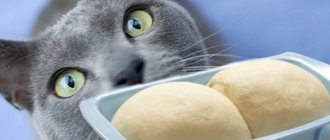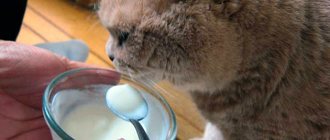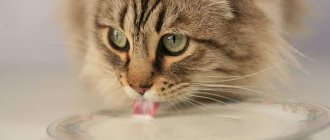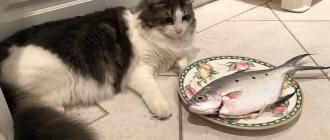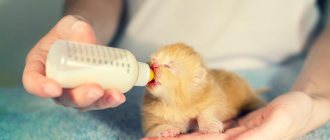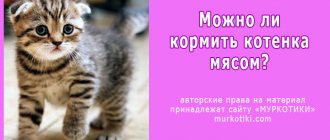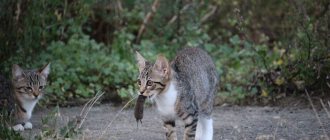Milk for kittens is a valuable, nutritious liquid that they receive from their mother. When the cat stops feeding the baby, he switches to solid food. The body reduces the production of the enzyme responsible for digesting milk. If you give your baby cow's milk instead of age-appropriate food, it may cause stomach upset.
Features of nutrition and digestion in kittens
Newborn kittens receive from mother's milk all the substances necessary for development. Cow and goat are not suitable because they do not contain the required amount of fat, protein, calories, and amino acids.
The milk that newborn kittens receive from their mother on the first day after birth not only transfers nutrients. The liquid contains antibodies that help babies fight viruses and bacteria that are dangerous specifically for cats.
A few days after birth, the amount of protein and fat in cat's milk increases. The latter contribute to the development of the nervous system of babies. Towards the end of feeding, the composition of the liquid changes, preparing the baby’s body for the transition to wet, then solid food of a carnivore.
How often should you feed
It is imperative to follow the regime and monitor the portions of the mixture. For the first two weeks, you will have to feed the kitten every 2 hours, even at night. Then the intervals are gradually shortened. After five weeks, the kitten can easily survive without food for 3-4 hours, and at night one feeding is enough for him.
At 6 weeks of age, babies feed on their own: they need to be fed up to 5 times a day and only during the daytime. Kittens grow very quickly, so the nursing period will not seem very long.
Why cats can't have milk
Kittens grow very quickly and gain weight, so up to 12-16 weeks, food should be high-calorie and not contain components that disrupt the functioning of the digestive tract. First of all, this applies to cow and goat milk.
Lactose intolerance in cats
Dairy products contain lactose, a type of sugar that consists of glucose and galactose. It imparts sweetness to the liquid, which is an advantage of a milk drink for humans. But cats' taste buds do not respond to it.
Moreover, with age, the digestive system of pets reduces the synthesis of the lactase enzyme, which helps process lactose. Excess lactose is retained in the body, settles in the intestines and begins to interact with bacteria. Therefore, diarrhea and bloating in cats is the main sign of lactose intolerance.
Interesting fact: cat milk contains much less lactose than cow's and goat's milk - 3.4% versus 4.6%.
Milk in the diet of adult cats
Cats are carnivores, 70% of their diet should be meat, and dairy food cannot replace it. Some pets tolerate the product normally, without diarrhea or bloating. But due to the lack of necessary nutrients, there is no point in giving a milk drink to adult cats.
Compatibility of milk with dry food
Another question that concerns owners of animals that consume milk is its compatibility with dry formulas.
Ready-made industrial food is a completely balanced product containing all the necessary elements, and there is no need for your cat to drink it with milk.
With the simultaneous intake of milk and dry formulas, an excess of nutrients and microelements appears in the cat’s body, which settle in the form of deposits on the walls of the bladder and kidneys, leading to the development of urolithiasis. The liver also suffers, since this protective barrier of the body is filled with toxins. This product is especially dangerous for castrated cats and sterilized females.
Pets should drink food only with clean running water.
Cow's milk, even if replaced with goat's milk, which is less dangerous for cats, is an element of natural nutrition, and mixing it with feeding dry industrial food, according to veterinarians, is unacceptable.
Can cats be given milk?
Do kittens get milk? Older babies who have switched to wet and solid food should not be given cow's or goat's milk. This usually happens by 8-10 weeks. Cats will not refuse dairy food, since the memory of the “taste of childhood” remains on the subconscious level.
Can kittens have cow's milk?
The maximum fat content of cat's milk is 10%, cow's milk is 3.6%. Can a small kitten be given cow's milk? No. It is unable to replace mother’s milk for a newborn, and is not needed for older pets. Moreover, the product cannot be given as the main food.
Cow's milk may not provide all the nutrients needed to keep your pet healthy. The fat present in the liquid contributes to weight gain and stomach upset in an adult cat. The low-fat product does not contain vitamins A and D, which help calcium and protein to be absorbed. This has a bad effect on the skeletal system.
Can kittens have goat milk?
Goat product contains more minerals and vitamins than cow product. It is fattier than cow's milk (6%), but this is not enough for a kitten. Goat milk has a little less lactose, so it is absorbed a little better than cow milk. However, once the kittens are on solid food, milk should be stopped.
The veterinarian can recommend a product for feeding a newborn kitten, giving a recipe for preparing the mixture. It is not recommended to give it in its pure form, since it does not contain many substances necessary for the normal development of the pet.
Can a kitten have milk from the store?
Is it possible to give a kitten store-bought milk? No. Mostly cow milk is sold in supermarkets and is not suitable for pets. Pasteurized products are especially harmful to cats. Studies have shown that it causes skeletal abnormalities, developmental defects and reproductive problems.
Moreover, do not buy cheap goods. Usually this is a low-quality product, where 2-3 tablespoons of dry powder are diluted with a liter of water, and there is not even a smell. A newborn will not benefit, and a grown pet will not need such food.
Can a kitten have powdered milk?
Pet stores sell dry food - cat milk substitutes. They can be given to kittens up to 8 weeks old if they are left without a mother or there is not enough milk. If there is no substitute on sale, the situation is critical; regular milk powder cannot be given. Call your veterinarian, who will tell you exactly how to prepare a formula for your newborn pet.
Is it possible to feed a kitten 1–1.5 months old with ready-made food?
Veterinarians and breeders have been arguing for many years about what is better to feed kittens - ready-made food or natural food. One thing is clear - mixing these types of nutrition is extremely undesirable. Some people choose industrial feed for two reasons:
- Saving time (no need to spend time preparing food).
- Ready-made feeds already contain correctly balanced nutrients, minerals and vitamins.
But those who have made their choice in favor of ready-made food need to know the following:
- You need to stick to one diet. If the house has run out of food, you cannot feed the kitten natural food (the baby’s body will suffer). Consequences: gastroenteritis, intestinal obstruction, etc.
- You cannot “jump” from one food to another. Each brand of food has its own recipes and principles (if you mix food from different brands, an imbalance of microelements or, for example, amino acids may occur).
- You need to choose only high-quality food (premium, super premium or holistic).
But not whiskey, not friskas, and not kitiket: there are special flavoring additives, but nothing useful. There is also food in bags or jars. This, of course, cannot be left in a bowl for a long time, but if there is an opportunity to stop by, then eating three times a day will be enough for him until the small one 250 grams per day is enough for him.
Fretka, forum user
https://forum.academ.info/index.php?showtopic=221934
If you decide to feed your kitten ready-made food, then it should be the best food you could find.
If the food is premium or super premium, there should be no problems, if “economy” such as whiskey, friskas, etc. - whatever. In nurseries, all cats on premium food are healthy and shiny, because... there is a balance of vitamins and microelements, and so you have to calculate everything yourself, and if you are not a specialist, then there will be a lack of vitamins or their overdose, which is even worse.
https://bvf.ru/forum/showthread.php?t=970243
Kittens prefer special wet food (canned food in jars or bags, as well as pates). However, dry food is cheaper, and some veterinarians believe that it is also healthier. There is a significant difference between these two types of feed in drinking mode. Wet food is 70-80% water, but dry food requires a lot of water. Month-old kittens fed the so-called “dry” diet are fed porridge from dry food - the granules are soaked in water. Gradually the amount of water is reduced and the amount of feed is increased. The most popular premium and super premium food for kittens are the following brands:
- Eukanuba Puppy Kitten;
- Royal Canin (Size Nutrition Mini Junior or Mother And Babycat);
- Bosch Sanabelle;
- Hill's Science Plan Kitten;
- Almo Nature;
- Pro Plan Junior, etc.
Photo gallery: some types of food for kittens at 1–1.5 months
Almo Nature food for kittens contains at least 50% animal protein and 14% non-allergenic rice
Bosch Sanabel kitten food is produced in Germany, the product composition is well balanced
Eukanuba food contains a lot of proteins, including 43% animal proteins (domestic chicken)
Hill's is famous for its rich composition of vitamins and minerals, but it may contain a large percentage of difficult-to-digest carbohydrates
"Proplan" can be bought in almost any pet store, it is very popular among Russian breeders
Seeing the price tag on a package of good food, the kitten owner may change his mind. But these numbers seem large only at first glance. After all, you don’t need to give a lot of good food (the kitten won’t remain hungry anyway), and with a balanced diet, you don’t need to buy any additional products (all vitamins are already included in the product).
Akana Grasslands food: A bag of Akana costs 2,250 rubles per 7 kg bag. 7 kg for two kittens for 55 days. The total weight of kittens is 5.72 kg 63.5 g per kitten per day. 1.972 kg per month per kitten. 22.2 g per kilogram of kitten per day. 690 g per kilogram of kitten per month. 20 rubles per kitten per day. 630 rubles per kitten per month.
Squirreland, regular forum visitor
https://forum-wec.com/index.php?showtopic=170823
Of course, a large package of food is always more profitable than several small ones. However, here you should take into account the number of kittens, the amount of food they consume per day and the shelf life of the product. I try to take medium-sized packages, since the food may run out before the kittens eat it. It is advisable to choose the packaging that has the latest production date.
What and how to feed a small kitten
If you picked up a kitten on the street or the cat does not have milk, the ideal option is to find a wet-nurse cat. To do this, ask your friends, advertise on social networks.
What kind of milk should be given to newborn kittens if a wet nurse has not been found? Buy kitten replacement from your veterinary pharmacy, which can be sold in liquid or dry form.
When a substitute is not sold in your city, ask your veterinarian how to prepare formula for feeding a kitten and what kind of milk to feed the kitten. You cannot feed your baby regular cow or goat milk; it must be mixed with yolk. Moreover, do not give condensed milk, the composition of which leaves much to be desired.
How to feed a newborn kitten
The pet must be fed from a special bottle with a nipple, which can be purchased at a pet pharmacy. If it is not there, you can take a pipette or syringe without a needle. In the second case, the mixture must be squeezed out slowly, otherwise the liquid may enter the trachea.
How much milk to give a kitten
A newborn kitten needs to be fed every 2 hours. You need to give:
- 2-3 ml of mixture per 1 feeding in the first three days of life;
- from days 4 to 7, the dose should be increased to 5 ml;
- at the age of 6-10 days – 5-7.5 ml.
Then the frequency of feedings decreases:
- from 11-14 days they give 10-12.5 mixtures, feeding every three hours.
- from 15-21 days – 10 ml of the mixture 8 times a day.
- from 21 days, give 7.5-25 ml 3-4 times a day, begin to introduce solid food.
Feeding instructions
- Dilute the mixture according to the instructions, heat in a water bath.
- Place a cloth on your knees, place the baby on his stomach, slightly raise his head.
- Give him a pacifier with a bottle.
- If you take the pacifier away prematurely, the baby will crawl and squeak. When he is full, he turns his face away and falls asleep.
- After feeding, remove any remaining food from the baby's fur.
- Place your pet on its back and stroke its tummy to start the process of digesting food.
- To avoid constipation and stimulate peristalsis, massage the kitten’s tummy and anus. If it doesn’t help, you can give an enema, but for the first time ask to do it yourself.
Options for replacement
Currently, many different milk replacers are produced, designed for pets of different breeds and ages. And every responsible cat owner should know how to replace milk if necessary. So, if a cat has an allergy or intolerance to this product, the following will come to the rescue:
- fermented milk products;
- infant formula diluted with water;
- a special balanced dairy product substitute that does not contain lactose, intended for cats with sensitive digestion. Currently offered by brands such as Beaphar (Kitty Milk), Gimpet (Cat Milk), Royal Canin (Babycat Milk).
Thus, the opinion of most veterinarians is that mustachioed pets are not prohibited from feeding low-fat milk if it is normally absorbed by the body. Cats with intolerance to it can be treated to fermented milk products, again, provided that their perception is normal. But in no case is it allowed to mix dairy products with ready-made feed.
Question answer
Is it possible to give a one-month-old kitten milk from a non-cat?
There is no point if the mother has enough of it. If your baby is hungry, buy a formula designed for kittens.
Why can't cats be given milk?
The product contains lactose, which the cat's body does not digest well. The result of such feeding is diarrhea, bloating, allergies.
What kind of milk can you give a kitten?
If your baby has already switched to solid food, do not give him a milk drink.
Is it possible to feed a kitten milk?
No. If you have a newborn kitten without a mother, it is better to buy a cat milk replacer.
Should a nursing cat be given milk drinks?
No. It is better to give vitamins and minerals that veterinarians recommend for pregnant and lactating cats.
What to give cats instead of milk?
If your pet eats natural foods, you can feed it fermented milk products.
Low-fat cottage cheese, sour cream, fermented baked milk and kefir - choose what suits the taste of a particular animal. You can try introducing natural low-fat curd cheeses into your diet. The most important thing is to give unsalted varieties. The products listed are also suitable for feeding kittens older than 2 months. When introducing them to your pet’s menu, consider the calorie content of each treat. Now you know whether a kitten can be given milk and how to properly introduce it into the diet. Follow all the nutritional recommendations, and then your tailed baby will grow up healthy and beautiful.
Caring for newborn and older kittens
To create comfortable conditions for furry babies, you need to take care of their place of residence. A large basin or cardboard box will serve as a “dwelling”, but you will have to constantly ensure that it does not get wet. For this purpose, absorbent material is purchased that absorbs excess moisture.
In the first days of life, kittens especially need warmth, so it is advisable to install a heater near their place of residence. If you don't have one, use a heating pad wrapped in a towel or a hot water bottle. Don’t forget: the minimum ambient temperature in the first two weeks of a baby’s life is kept at 30° C. After 14 days, lower the temperature to 24° and do not change it for another three weeks.
At three weeks of age, babies begin to try to walk: be careful that they do not fall out of their nest and get injured. The first walks should take place under your watchful supervision.
Try not to let kittens onto the carpet: they do not yet know how to retract their claws and therefore constantly cling. In worst cases, the baby may be injured.
At the fifth week of life, kittens see well and move actively. Then they are introduced to the first complementary foods. By 6 weeks of age they can eat solid food, and at 8-10 weeks they can be given to new owners.
To monitor the development of kittens, you will need an accurate scale. Weighing babies is necessary for:
- calculating the volume of daily portions;
- tracking growth rates.
If your kitten is not gaining weight well, you should consult your veterinarian. Perhaps the baby is malnourished or sick with something.
Milk replacer
Can cats drink store-bought milk? Many people choose store-bought pasteurized formulations as a substitute for cow's milk, but these products are also unacceptable for feeding animals.
An absolutely useless drink that loses all useful microelements during preparation and processing. Disadvantages also include calcium, which after pasteurization is not processed, but is deposited in the body and is practically not excreted, which contributes to the development of very unfavorable diseases.
Benefits and harms
Despite numerous statements by scientists about the indispensability of cow's milk, this product in the diet of pets is considered absolutely useless and even harmful.
Experienced veterinarians even advise owners of purebred animals to replace this product with dry or wet food that is more nutritious and beneficial for animals.
What is the uselessness and harm of milk:
- There are a lot of calories in a whole drink, and their excess in the body of cats can lead to metabolic imbalance, which will lead to obesity;
- the composition contains quite a lot of casein and lactose, which are poorly absorbed by the animal’s body;
- against the background of intolerance to the incoming components, the cat can very quickly develop an allergic reaction;
- very often, feeding cow's milk to adults ends in banal diarrhea, which can also turn into a chronic form, in which serious dehydration of the body is observed;
- in addition to stool disturbances, the cat develops flatulence, bloating and other painful symptoms.
This futility is noted when feeding adult cats. As for kittens, the diet of small pets must include milk, preferably natural mother's milk.
If there are insurmountable difficulties with breastfeeding, it is necessary to find a useful replacement that can bring undeniable benefit and not harm to the body of a growing animal.
Is it possible to replace milk with fermented milk products?
Fermented milk products are the result of milk fermentation. Bacteria, yeast and fungi that take part in ripening attack pathological microorganisms and help strengthen and enhance the cat's immune system.
Milk souring lasts from 10 to 24 hours. The duration of ripening depends on the final product. Kefir and other fermented milk products (yogurt, biokefir, cottage cheese, etc.) are absorbed by the cat’s body by 70-90%, and milk by only 30%.
Also, during fermentation, the amount of B vitamins increases. Fermented milk products are rich in beneficial microorganisms and bacteria. They form a layer on the intestinal and stomach mucosa that protects the pet’s body from microbes.
It is useful to introduce the following products into your cat's diet:
- Cottage cheese, sour cream, yogurt (without added sugar), fermented baked milk, yogurt. They are obtained by lactic acid fermentation.
- Kumis and kefir. Such products are obtained by alcoholic and lactic acid fermentation.
REFERENCE! Veterinarians do not recommend feeding fresh kefir to cats. It is better if it stands in the refrigerator for 2-3 days, this will avoid stool upset. If your pet doesn’t like the sour taste of the product, you can offer him biokefir.
What quantity is acceptable? Features of one month of age
As already mentioned, kittens are often fed with special ready-made formulas, especially when they are left without a cat.
They do this until almost 4 months. The product stock is prepared immediately for the day. Keep it in the refrigerator to maintain freshness and beneficial properties. When self-feeding, the mixture is given after 2 - 3 hours. The daily norm at the age of 1 month is 30 ml per 100 g of body weight. Before feeding, milk is heated to 38 degrees.
But you can make a mixture for a kitten yourself according to this recipe: take 50 g of cow's milk, milk powder, yeast, egg, cream. This composition contains all the ingredients that a pet’s growing body requires.
Artificial feeding of a kitten should follow the same rules as with a cat:
- Choose a warm, cozy and quiet feeding area.
- Place the kitten on its tummy.
- You need to purchase special nipples, which are available in pet stores.
- Hold the pacifier at a 45 degree angle.
- It is not recommended to force your baby to eat more than he wants.
- In the first couple of weeks, feed your pet every 2 hours.
- You can try solid food only after 1 month.
Attention!
Another important nuance is that for the first time after birth, the kitten cannot go to the toilet on its own. If there is no cat, then he will need help - stroking his tummy after feeding - if this is not done, then the baby will become intoxicated and he may die.
Over time, the kitten grows and learns to do everything on its own thanks to unconditioned reflexes.
What breed is this product completely contraindicated for? Features of Scottish and British
If we talk about which breeds milk is completely contraindicated, then these are Scottish kittens.
Some believe that the cause is the ability of the ears to stand up - this is a real myth.
In fact, starting from 3 months, pets of this breed more often than others stop digesting lactose normally and, like some people, they develop complete intolerance. The same applies to the British.
Not all cats feel a negative reaction to milk; some may greedily pounce on the product and love it very much, despite the ban and subsequent poor health.
As a result, diarrhea, increased gas formation and indigestion develop. For this reason, after 3 months, kittens are no longer given any milk.
Despite the ban on milk, it is beneficial for cats to consume fermented milk products - they are rich in calcium and contribute to the proper intestinal microflora of the animal. You should not choose too fatty fermented milk products; it is recommended to give preference to kefir, low-fat fermented baked milk, natural yogurt and yogurt.
For information:
sour cream is not the best choice. Fermented milk food is served separately and should not be mixed with other kitten food.



